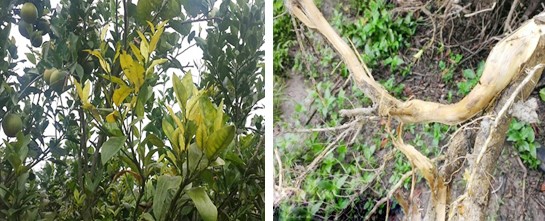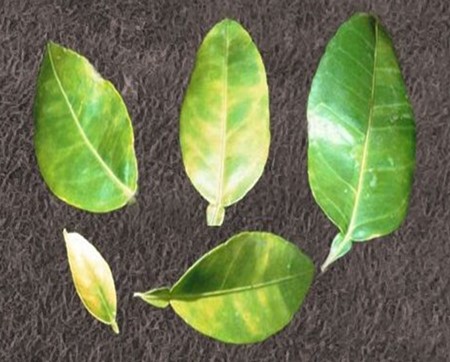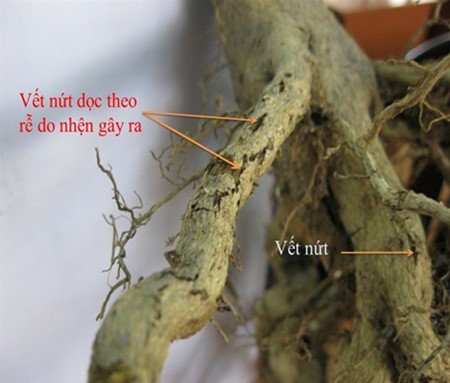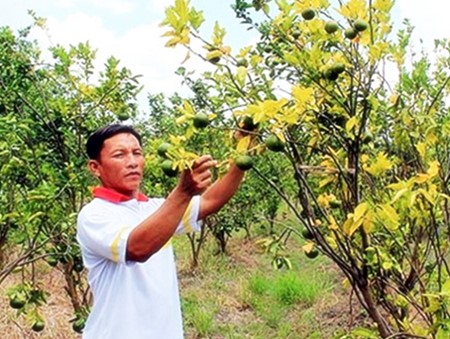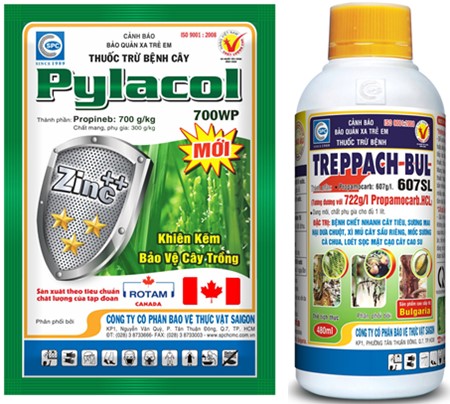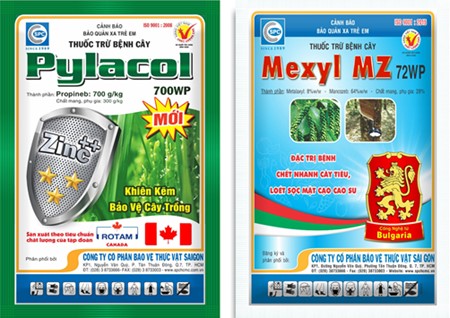|
ROOT ROT YELLOW LEAF DISEASE ON CITRUS TREES
21/06/2023
ROOT ROT YELLOW LEAF DISEASE ON CITRUS TREES 26/05/2022 In recent years, the area of citrus trees in the Mekong River Delta has increased significantly, due to the high profits of intensive growers. However, the increase in acreage and intensification causes growers to face many challenges. One of the top challenges is the complication of the pest situation. Gardeners have to live with dangerous pests such as yellow leaf disease, green veins, ulcers, scabs, red spiders, fruit borers, yellow leaf rot, root rot... In which root rot yellow leaf is the most ominous pest.
Root rot yellow leaf is caused by a variety of pathogens including Fusarium, Pythium, Phytophthora, Rhizoctonia, nematodes and root mites. The disease does not appear immediately in the rainy season, when the soil is soggy, but the disease often appears seriously in the early sunny season. When the disease first appeared the leaves of the tree were still normal but the veins were pale yellow, the leaf blades turned orange-yellow and fell easily. When the wind blew, the lower leaves fell first, then the upper leaves; Fruit quality is poor and falls prematurely; Severe disease can kill the whole tree, if not treated in time. In which direction the branch is diseased, the roots will often rot in that direction. Root system rot from small roots spread gradually into large roots. Rotten roots are brown, root bark slips out of the wood, inside there are brown stripes that gradually spread to the taproot. The roots lose the ability to absorb water and nutrients to nourish the plant, thereby causing the branches to die. When seriously diseased, all the roots turn black and die, eventually the whole plant dies.
Causes and conditions of disease occurrence: Direct cause: - Nematodes, soil mealybugs and root-damaging spiders are the main causative agents of root rot yellow leaf disease. Because they create wounds on the roots, reduce the immunity of the roots, thereby creating favorable conditions for the fungal combination (Fusarium, Pythium, Phytophthora, Rhizoctonia) to invade and cause harm. Indirect causes: - The garden is made with low beds and mounds, poor drainage and often being flooded, or in the process of reducing water of flowering treatment to weaken the roots, some roots go deep down when the rain comes, the untimely drainage makes the roots waterlogged, lack of oxygen leads to roten root tips and suction hairs. - The garden uses less organic fertilizers and overuses chemical fertilizers. Especially using fertilizers containing NAA, IAA growth stimulants..., excessively leading to rapid aging of the roots and breaking the soil structure, causing beneficial antagonistic microorganisms in the soil to be destroyed and the harmful microorganisms reproduce quickly. From there, weakening the roots and weakening the immune system of the roots, the young roots gradually die, creating opportunities for fungal combinations (Fusarium, Pythium, Phytophthora, Rhizoctonia) to develop.
Measures to prevent root rot yellow leaf on citrus trees: - The garden for growing citrus trees must be high and dry and well-drained. If the garden is low, the embankment must be built to control water in the rainy season. - Select disease-free seedlings. The garden must have a good drainage system. - Prune branches, shape the tree as soon as the tree is young, regularly prune, remove old weak branches, pests. - Remove severely diseased plants that are not able to recover, - Apply lime at the beginning of the rainy season to disinfect, prevent fungal diseases and raise soil pH to help plants grow well. - Check the garden regularly to detect the earliest for timely preventive measures. - Increase the use of organic fertilizers, especially microbial organic fertilizers (eg HCVS1 VIETSTAR fertilizer) to stabilize the soil structure, increase humus, loose soil and destroy harmful pathogens present in the soil. - Should add CALCIUM NITRATE 3 times a year to increase the immunity of the roots and the resistance of the plants. - Treatment of nematodes, soil mealybugs and root-damaging spiders around the root zone such as: Comda 250EC, Sago Super 20EC, periodically 2-3 times/year. Especially in the dry season. - Root rot yellow leaf disease is very difficult to treat, so it is necessary to pay attention to monitor the garden and spray early to prevent disease. Recently, Saigon Plant Protection Joint Stock Company has conducted a number of tests in Lai Vung - Dong Thap and has selected 2 spray treatments with good effect on preventing root rot yellow leaf disease on citrus trees: • Treatment 1: Mix 500g Pylacol 700WP + 480ml Treppach Bul 607SL for 200 liters of water, irrigate 250m2, water evenly on the bed surface
• Treatment 2: Mix 500gr Pylacol 700WP + 500gr Mexyl MZ 72WP for 200 liters of water, water for 250m2, evenly water on the bed surface
Preventive spraying: Treat the garden with treatment 1 or treatment 2, watering 3 times a year at the beginning of the rainy season, in the middle of the rainy season and at the end of the rainy season. Combine spraying Dipomate 430SC through leaves after finishing each watering for 03 days, with a dose of 1.0 liter Dipomate 430SC for 200- liter-water drum to spray evenly on foliage. Spray when early disease appears scattered on a few branches on the canopy: Treat immediately with treament 1 or treament 2, watering 03 times, each time 07 days apart. Combine spraying Dipomate 430SC through the leaves after finishing the last watering for 3 days, with a dosage of 1.0 liter of Dipomate 430SC for a drum of 200-liter-waterdrum to spray evenly on the canopy. |
To prevent, in addition to plowing and burying weed seeds, collecting weed stalks and stumps left after tilling the land to burn, not letting weeds produce seeds in production fields, etc., the use of chemical products is still a measure. optimal because of its ability to thoroughly kill weeds, reduce labor and take advantage of more time than manual weeding.
Miner has the scientific name Phyllocnistis citrella Staint., family Phyllocnistidae, order Lepidoptera. The miner occurs in many countries in the tropics and subtropics. The main host of the miner is the citrus family - Rutaceae. In addition, the miner also attacks mangosteen and some other plants.
Adult is a small planthopper, with a body 2-3 mm long, the whole body is ash gray, slightly greenish, the wings are opaque with many small brown spots.Eggs are oval, 0.3 mm long, have a pointed end and are attached directly to the leaf surface, leaf axils.
Green bugs specialize in the fruit of citrus groups (oranges, tangerines, lemons, grapefruits, kumquats...), some people call them orange bugs, or orange suckers. Their scientific name is Rhynchocoris poseidon or Rhynchocoris humeralis.
In Vietnam, yellow leaf curl disease is very common on papaya trees, especially the disease is often severe in areas of high and continuous planting, areas with hot and arid climates. The disease has significantly reduced the yield and quality of papaya. Gardens that are infected early when the plants are young may not yield. However, up to now, many gardeners still do not know the cause and how to fix it.
Spider mites are common pests on citrus trees, especially in hot and dry climates that are suitable for spiders to grow and cause severe damage.The group of harmful spiders is usually very small in size, unlike the natural enemy spiders.
This group includes species that are generally very small in size, causing damage by sucking plant sap (on leaves, fruits, branches, stems).
There are many species of mealybugs present on the group of Oranges,Tangerines,Grapefruits and Lemons (Citrus), which can be divided into 2 groups:
+ Group of sticky mealybugs with common varieties such as Lepidosaphes, Aonidiella, Coccus and Saissetia.
+ Group of flower mealybugs with common genera and species such as Pseudococcus, Planococcus and Icerya purchasi.
Dry branches and berries disease often appear to be common damage on coffee gardens during the rainy season. The disease causes death of branchs, dry fruit, severely affects the canopy structure and coffee yield if not paid attention to prevention.
Pink disease commonly causes diseases on rubber plantations in the rainy season, especially on garden from 4-8 years old. This year, rubber has to go through a period of severe drought, weakening the tree, so now in tnshe rainy season it is easy to get infected. Therefore, it is necessary to pay attention to good management to avoid affecting the garden.
In recent years, the area of citrus has been expanded because it is a fruit tree with high economic efficiency. However, in order to sell at a high price, not only in quality but consumers also require the external beauty of the fruit, so pest management on citrus is a matter of great concern to farmers. The hot season is a favorable condition for thrips to develop and cause damage, affecting the commercial value of fruit.
- Headquarters
- SAIGON PLANT PROTECTION JOINT STOCK COMPANY
- RQ 1, Nguyen Van Quy St., Tan Thuan Ward, HCM City
- Tax code: 0300632232
- Tel: (028) 38 733 295 - 38 732 077
- Fax: (028) 38 733 003 - 38 733 391
- Website: www.spchcmc.vn - Email: info@spchcmc.vn
- SAIGON PLANT PROTECTION COMPANY
- SAIGON PLANT PROTECTION JOINT STOCK ENTERPRISE
- Lot C1-C3 Hiep Phuoc Industrial Park, Hiep Phuoc Commune, HCM City
- Tel: (028) 3873 4089 - Fax: (028) 3873 4086
- Affiliated Unit
-
- Quick Links
- Home
- About us
- Career Opportunities


